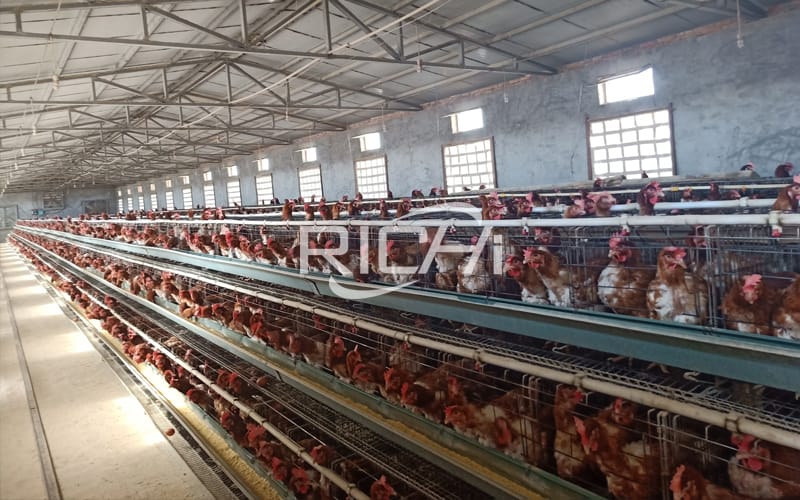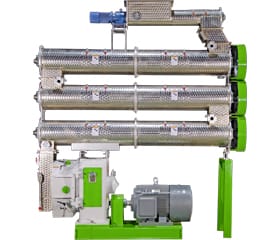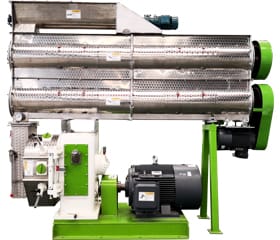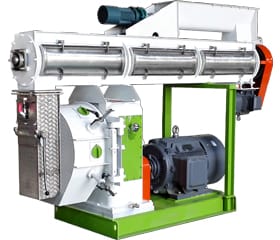Broiler breeding technology in plastic shed
With the continuous development of the breeding industry in recent years, the number of broilers raised in large-scale plastic greenhouses has continued to increase. The raising of broilers in plastic greenhouses has become an important way for farmers to get rich quickly. It not only has relatively little investment in fixed infrastructure, but it can also be raised in large quantities, and it is easy to scale up and upgrade in quantity. Richi Machinery has accumulated a lot of experience in chicken feed processing projects for many years, including many projects that can be used to raise broilers in plastic greenhouses. Today, Richi Machinery will introduce the management techniques of broiler chickens in plastic greenhouses in winter to everyone. Hope it helps to you!(The following content takes China's plastic greenhouse chicken breeding technology as an example)

1. Site selection and construction of plastic greenhouses
Large-scale chicken sheds are built in leeward, sunny, well-drained, convenient transportation, adequate water and electricity, high and dry places. In order to facilitate ventilation and winter lighting and heat preservation, it is best to build sheds in the east-west direction. The shed is arched, the height should be above 2-2.5m, and the length and width depend on the scale of breeding. Generally speaking, the construction of the greenhouse is based on 1.5m on the left and right sides of the center axis of the site, and a column is buried every 2m. The top of the constructed plastic greenhouse should be covered with grass curtains and rain-proof film to prevent the grass curtains from being mildewed or being blown up by the wind after the rainwater enters, which will alarm the chickens in the shed. The surrounding plastic film should be properly extended, sealed and folded, and sealed with a cable along the shed so that it can be rolled up and received sunlight and ventilation. Both ends of the greenhouse must be set up with movable doors. There is a vent hole with a diameter of about 50 cm every 3 m above the roof.
2. Preparation before brooding
Before brooding, clean the ground soil of the greenhouse thoroughly, remove the old soil 2-3m deep on the surface, replace it with new pollution-free soil, level and compact it. After the ground of the greenhouse is dry, the greenhouse is sealed and fumigated with formalin (30 inL/m3) and potassium permanganate (15 grams) for 24 hours, and the membrane is opened for ventilation to remove formaldehyde and possibly other toxic gases. Before use, spread clean and dry bedding with a thickness of not less than 5 cm on dry ground, such as short straw, wheat straw (6-10 cm), rice bran, peanut shells, etc. (dry sand can be used as bedding later). Arrange all drinking water and feeding utensils evenly. Then use 2.5% fire lye to spray and disinfect the floor, drinking fountains, and troughs in the shed for more than 12 hours, then rinse with clean water and dry for later use.
3. Environmental control in the plastic greenhouse
(1)Temperature
The plastic greenhouse has good light transmission, fast heat absorption and high temperature. When the shed is heated slightly, the temperature will rise to 35°C. If the chicks are raised on the ground, they can be directly laid with bedding and fences should be erected at the feet of the shed to prevent the chickens from escaping. If online brooding is implemented, a post and a net must be erected. When deciding the height of the net, the convenience of removing manure must be fully considered. The net frame is generally 1 to 1.3m high and 2-3m wide. The 2 rows of grids extend longitudinally, leaving an aisle in the middle. Generally speaking, the temperature in the shed should generally not be lower than 18°C, and the temperature should be kept at 33-35°C for one week of age, and then lower 2-3°C every week until about 21°C.
In addition to observing the thermometer, whether the temperature is appropriate can also be judged by observing the activities of the flock. When the temperature is right, the broiler chickens behave lively, evenly distributed, good appetite, proper drinking, do not crowd during sleep, quiet, no screaming; when the temperature is too high, the chicken will not move, stay away from the heat source, open their mouths and pant. Decreased food intake and increased drinking water, often diarrhea phenomenon, long-term high temperature slows growth and development, feathers lack luster; temperature is too low, broilers actively close to the heat source, scream, sleep at night is not quiet, easy to pile up or even appear For crushing or suffocation, the temperature in the shed should be adjusted flexibly according to different situations. Common methods for adjusting the temperature in the shed are as follows: use plastic film to divide the floor or grid into a small area, install light bulbs of different power and color in the shed every 5-8m, use a ground stove or coal stove to heat, and According to the size and number of chicks, gradually increase the area of brooding.
(2) Ventilation
One of the most important measures for raising chickens in greenhouses is ventilation. Generally, a wooden stick can be attached to the edge of the plastic film to make it movable. When ventilating, just roll up the edges. At the same time, it should be noted that this ventilation is based on heat preservation. It is necessary to prevent the intrusion of wind and direct wind from the chicken body, especially after 25 days of age, in addition to increasing the temperature in the shed. According to the temperature, humidity and air turbidity in the normal shed, the ventilation holes should be opened to ventilate, reduce the concentration of harmful gases such as dust, carbon dioxide and nitrogen in the house, reduce the interior degree of the house, and keep the air fresh.
(3)Humidity
Chickens in greenhouses are generally raised on the ground with litter, and the litter is mostly short straw, wheat straw, rice bran, and peanut shells in rural areas. In winter, there is a large temperature difference between day and night in the northern area. Due to the fire in the shed, the temperature difference between inside and outside is large. When the heat reaches the roof of the shed, it turns into water droplets and falls to the ground when it is cold. Generally speaking, in the first 3 days, the relative humidity in the chicken house is about 70%, which is beneficial to promote the absorption of yolk in the belly of the chicks and prevent the dehydration of the chicks. After 10 days of age, the relative humidity of broilers should be maintained at about 55% to 60%, so as to keep the shed dry and prevent the broilers from causing leg disease and coccidiosis due to wet litter.
(4)Light
The purpose of light is to extend the feeding time of broilers and promote growth. Generally, the light time for the first 2 days of breeding chickens should be continuously reached 48 hours, and then changed to 23 hours of light, and lh is darkness. The darkness of this lh should be kept for a certain period of time and cannot be changed at will, so that the chicken can adapt to the sudden power failure. Changes in the environment to avoid death from fright.
The light intensity changes from strong to weak. Install a cypress w bulb every 20m2 on the ground for the first 2 weeks, then replace it with a 15w bulb so that broilers can see the food trough and sink. In addition, in the uniform distribution of light intensity, do not use bulbs above 60w, the lamp height is 2m, and the lamp distance is 2-3m. In this way, by controlling the growth in the early stage and recompensating the growth in the later stage, it will not affect the weight of the broiler when it is released, and it can also increase the feed conversion rate and reduce the incidence of broiler ascites.
4. Hygiene management and disease prevention
To do a good job in the hygiene management and disease prevention of broiler chickens raised in plastic greenhouses, an all-in, all-out system should be adopted. After the sale, the greenhouse and its environment shall be thoroughly cleaned and disinfected.
(2)Stocking density
The stocking density of broilers should be determined according to different ages, seasons, temperature, and ventilation conditions. Generally speaking, 1-2 weeks old chicks can raise 30-40 chickens per square meter, and 2 to 4 weeks old can raise 20-25 chickens per square meter. After 4 weeks of age, only 8-12 chickens per square meter can be raised. Chickens. The breeding density of broilers in winter is higher than in other seasons. It is reasonable to raise 8 weeks old on the ground at 12 per square meter, which is beneficial to increase the temperature in the shed.
(3)Drinking water
When the chicks are just connected to the brooding shed, they should drink water before feeding, preferably warm water. Drinking water can be added with water-soluble vitamins and trace elements, which can promote the growth and development of chicks and improve the survival rate. The number of drinking fountains must be sufficient and placed evenly. A round drinking fountain of 4 to 5 L can be used for drinking water for 100 chicks. The height of the waterer should also be adjusted gradually with the growth of the chickens to prevent the drinking water from overflowing and keep the litter dry. The quality of drinking water requires freshness, cleanliness and hygiene. Drinking fountains are cleaned and disinfected regularly.
(4)Feeding
The chicks began to feed 2-3 hours after drinking water. At first, the chicks should be fed the full-price feed of the broilers as soon as they start, and the feed is sprinkled on a clean feeding tray to allow the chickens to eat freely, unlimited. After 4 to 5 days, the feeding tray is gradually withdrawn, and after 1 week, a round barrel or long trough can be used. Except for feeding restriction in the second week, free intake at other times. In the second week, feeding restriction is implemented, and feeding 90% full can reduce the occurrence of sudden death syndrome in broilers.
Feeding times should be appropriate, generally 6-8 times a day, not too much feed each time, do not exceed 1/3 of the depth of the trough as a standard, too much will cause waste. 4-5 weeks old with mid-term chicken feeds, 6 weeks old to slaughter with late chicken feed. There should be a gradual transition when changing feed between stages, with an adaptation period of 3 to 5 days. If the broiler chicken feed is changed suddenly, the broiler will have a greater stress response and cause disease in the flock.
(5)Develop scientific immunity procedures
4 to 5 years old chicken kidneys transmit weak vaccines, H120, drink twice as much water or eye drops. For 7-14 day old chickens, Newcastle Disease II strain 2 times or IV strain 1.5 times the amount of water or nose drops. 16-18 days old bursa of bursa poisoning or double the amount of lyophilized bursa lyophilized vaccine, 23-25 day old poultry cholera oil vaccine is injected subcutaneously with 0.5 mL per chicken (rapid chicken can Exempt), 27-29 day old chickens with Newcastle disease IV vaccine double the amount of drinking water (such as 7-9 days old who have been injected with Newcastle vaccine can be exempted).
Note: You should read the instruction manual of the vaccine in detail before immunization, implement the immunization according to the requirements, you can not increase or reduce the dosage of the vaccine at will, and you can’t save it and mix it with other vaccines or drugs. In general, the schedule of Newcastle disease and bursal immunization should be separated by 2 days, and the spread should be separated by 4 days.
(6)Improve drug prevention
While adhering to vaccine immunization, common diseases such as pullorum and coccidiosis should be prevented by drinking water or mixing materials regularly. In general, broilers are raised in plastic greenhouses, and the early stage (1 to 7 days old) should focus on prevention and treatment of diseases such as Salmonella, E. coli, Pseudomonas aeruginosa, and Mycoplasma due to hatching and inadequate disinfection. As the chicks grow, maternal antibodies are basically consumed, and the first peak of disease (7-21 days old) will appear. Mainly prone to diseases such as mycoplasma, renal tract respiratory tract, coccidia, bursal bladder, Newcastle disease, etc. At this time, after the Newcastle disease vaccine is given, drugs to prevent respiratory diseases are added. In the later period (21-35 days of age), the chicken flock grows fast and has a strong metabolism.
If the management can not keep up at this time, the air in the chicken house will be dirty, and the respiratory mucosa of broilers will be easily damaged, which can easily cause E. coli, respiratory tract, coccidia and other diseases. Generally at this time, electrolytic multidimensional can be added during the dressing, transfer group and vaccination to reduce stress, or antibacterial drugs should be fed during the dressing and transfer group to prevent the occurrence of E. coli disease caused by stress.
If you want to built one complete pellet production line in your country, pls send the inquiry to us. We will customized design according to your requirement.



